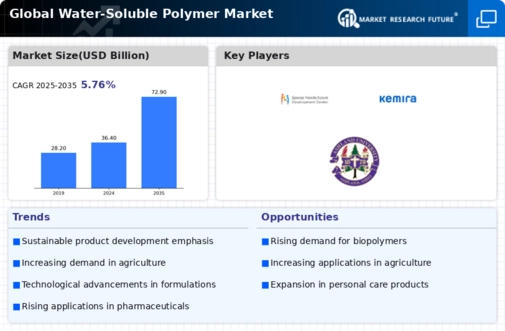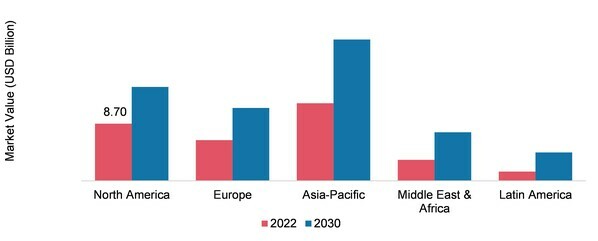Market Share
Introduction: Navigating the Competitive Landscape of Water-Soluble Polymers
The competition in the water-soluble polymer market is being reshaped by the accelerated technological development, the stricter regulatory environment, and the changing consumer demand for performance and safety. Whether it's the original equipment manufacturers (OEMs), the special chemicals companies, or the new entrants, they are all competing for leadership in the water-soluble polymer market by introducing new advanced products and services with the help of the IoT and AI. The established players are focusing on the green construction to meet the regulatory requirements and the demand of consumers. The new entrants are introducing new formulations to meet the requirements of the niche applications. The strategic trends for 2024–2025 will be characterized by the establishment of strategic alliances and the increase in R&D investment. The regional markets in Asia-Pacific and North America are expected to be the main growth markets. The C-level managers and strategic planners need to be aware of these interplays to navigate this changing landscape.
Competitive Positioning
Full-Suite Integrators
These vendors offer comprehensive solutions across multiple segments of the water-soluble polymer market.
| Vendor | Competitive Edge | Solution Focus | Regional Focus |
|---|---|---|---|
| BASF SE | Broad product portfolio and innovation | Chemicals and materials | Global |
| The Dow Chemical Company | Strong R&D capabilities | Specialty chemicals | North America, Europe, Asia |
| DuPont | Diverse applications and sustainability focus | Advanced materials | Global |
Specialized Technology Vendors
These players focus on niche technologies and innovative solutions within the water-soluble polymer space.
| Vendor | Competitive Edge | Solution Focus | Regional Focus |
|---|---|---|---|
| SNF Group | Expertise in water treatment solutions | Water-soluble polymers for various applications | Global |
| Kemira | Strong focus on water-intensive industries | Chemicals for water treatment | Europe, North America |
| KURARAY CO., LTD. | Innovative polymer technologies | Specialty chemicals and polymers | Asia, Europe, North America |
Infrastructure & Equipment Providers
These vendors supply essential materials and equipment that support the production and application of water-soluble polymers.
| Vendor | Competitive Edge | Solution Focus | Regional Focus |
|---|---|---|---|
| Arkema S.A. | Strong focus on high-performance materials | Specialty chemicals and polymers | Global |
| Ashland | Tailored solutions for diverse industries | Specialty chemicals | Global |
| Mitsubishi Chemical Corporation | Diverse product offerings and innovation | Chemicals and materials | Asia, North America, Europe |
Regional Players
These vendors are key players in specific regional markets, providing localized solutions and expertise.
| Vendor | Competitive Edge | Solution Focus | Regional Focus |
|---|---|---|---|
| Nitta Gelatin, NA Inc. | Specialization in gelatin-based products | Gelatin and water-soluble polymers | North America |
| Gantrade Corporation | Strong distribution network | Chemical distribution | North America, Asia |
| Akzo Nobel N.V. | Sustainability and innovation focus | Coatings and specialty chemicals | Global |
| Sumitomo Seika Chemicals Co., Ltd. | Expertise in specialty chemicals | Water-soluble polymers | Asia |
| CP Kelco U.S. | Focus on natural and sustainable products | Hydrocolloids and gelling agents | Global |
| Shandong polymers Bio-chemicals Co. Ltd. | Cost-effective production capabilities | Bio-based polymers | Asia |
Emerging Players & Regional Champions
- Aqualon Company (USA): Specializes in cellulose-based water-soluble polymers, recently secured a contract with a major food manufacturer for sustainable packaging solutions, complementing established vendors by focusing on eco-friendly alternatives.
- KRATON CORPORATION, U.S.A.: Known for its polymers that increase water solubility, the company has just completed a project with a personal care brand to develop biodegradable products, thus challenging the polymer suppliers' business models.
- Sabic (Saudi Arabia): Produces advanced water-soluble polymers for use in agriculture, has recently teamed up with a local agricultural company to improve crop yields, and is now positioning itself as the new regional champion of the chemical industry, a rival to the established chemical companies.
- Ashland Global Holdings Inc. (USA): Focuses on specialty water-soluble polymers for pharmaceuticals, recently expanded its product line to include bio-based options, complementing established vendors by offering more sustainable choices.
- BASF SE (Germany): Launched a new line of biodegradable water-soluble polymers for the textile industry, recently collaborated with a leading fashion brand, challenging traditional polymer manufacturers with their innovative solutions.
Regional Trends: The resolutely growing demand for sustainable packaging and agricultural solutions in Asia-Pacific is a major driving force behind the growth in the consumption of water-soluble polymers in 2023. North America continues to lead the way in terms of technological developments, especially in the field of bio-based polymers, while Europe is focused on compliance with regulations and the development of eco-friendly solutions. The trend towards a more sustainable future is driving both the newcomers and the established suppliers to change their products and services.
Collaborations & M&A Movements
- BASF and Ashland formed a partnership to develop innovative water-soluble polymer solutions aimed at enhancing sustainability in the personal care industry, thereby strengthening their competitive positioning in the eco-friendly product segment.
- Kraton Corporation acquired the water-soluble polymer business of the specialty chemicals company, enabling them to expand their product portfolio and increase market share in the adhesives and coatings sector.
- DU POLYMERS AND EVONIK INDUSTRIES AGR. CHEM. CO., INC. AND DOW CORNING CO., INC. HAVE JOINED FORCES TO IMPROVE CROP PRODUCTION AND IMPROVE THE ENDS OF CROP STRUCTURES AND TO IMPROVE THE ENDS OF CROP STRUCTURES AND TO IMP
Competitive Summary Table
| Capability | Leading Players | Remarks |
|---|---|---|
| Sustainability | BASF, Dow, Ashland | With its bio-based water-soluble polymers, BASF is reducing its carbon footprint. And the commitment to sustainable sourcing is leading to the development of products that are eco-friendly. Ashland's focus on biodegradable polymers is in line with the growing regulatory focus on sustainability. |
| Product Innovation | SNF Floerger, Kraton, Solvay | Snf Floeger has launched new water-soluble polymers for the viscosity control of various products. Their versatility in various industries is a clear indication of their R&D capabilities. The Solvay focus on special polymers has led to unique formulations that meet customer needs. |
| Customization | Evonik Industries, Hercules, Clariant | Whether for special applications or for general use, Evonik offers tailored solutions and enhances customer satisfaction. It is with its Hercules brand that the company provides a flexible range of oil and gas industry polymers. This ability to modify the properties of the polymers to suit the respective end-use applications is an example of the company's customizing skills. |
| Global Reach | DuPont, Wacker Chemie, Kemira | DuPont has a strong distribution network that ensures the availability of its products in all regions of the world. Wacker Chemie has a worldwide presence, which enables it to serve a variety of markets effectively. Strategic alliances have further enhanced Kemira’s international reach, allowing it to serve its customers better. |
| Technical Support | Huntsman, AkzoNobel, Mitsubishi Chemical | Huntsman provides extensive technical support and application development services to enhance the performance of its products. Huntsman and AkzoNobel have dedicated technical teams that help customers optimize their use of polymers. In the case of Mitsubishi, close collaboration with customers ensures that both companies can work together to solve problems and develop new products. |
Conclusion: Navigating the Water-Soluble Polymer Landscape
In the water-soluble polymer market, competition is intense and the market is fragmented. Both the established and newcomers compete for the leadership of the market. The regional trends show an increasing demand for sustainable solutions, which makes suppliers change and adapt their offerings. The established players use their established distribution networks and brand loyalty, and the newcomers are focusing on flexibility and new technology. For suppliers, this means that they must invest in capabilities such as artificial intelligence for improved product development, automation for increased efficiency, and sustainable practices to meet both regulatory requirements and consumers' preferences. These suppliers who are able to integrate these capabilities will be the leaders in the changing landscape.







Leave a Comment